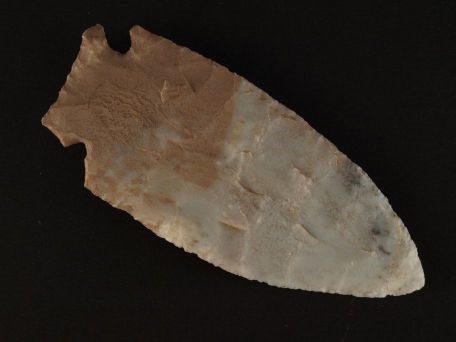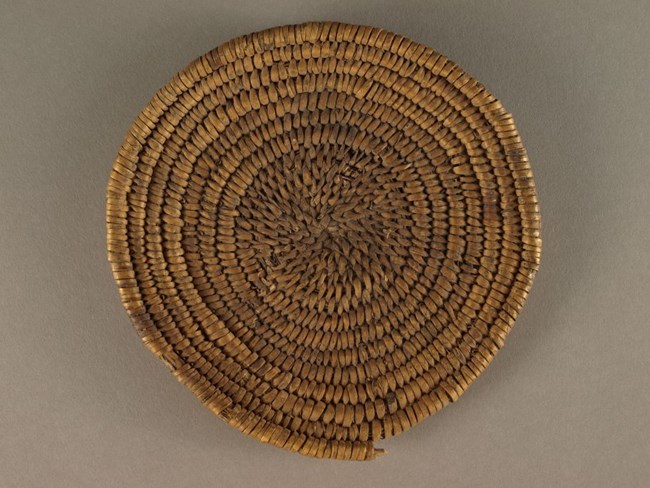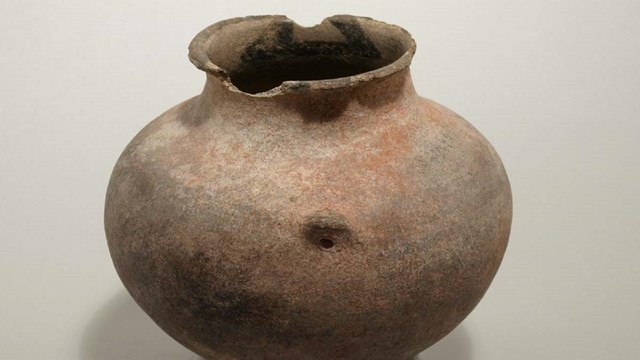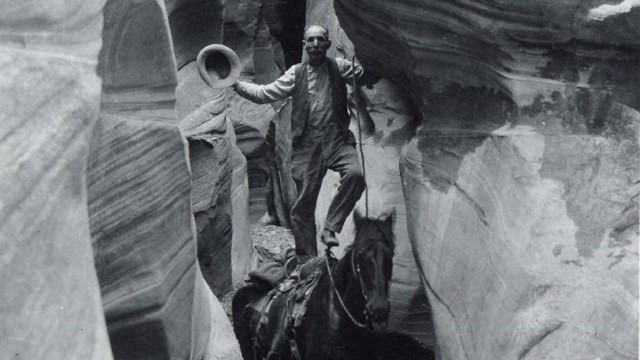|
Artifacts are the things that people in the past made, purchased, collected, and left behind at archeological sites. Archeologists carefully collect artifacts from their archeological contexts, then study and curate them. Artifacts can tell us where people lived; what they ate, wore, and used; and how culture changed over time. See below for a few of the artifacts in the Zion Museum Collection and the stories they tell. 
Zion Museum Collection ZION 2382 Yucca SandalIt is very rare and exciting for researchers to uncover organic material completely intact, like this yucca sandal. Finding organic, perishable material while excavating archeological sites provides information about the specific types of plants and animals people chose to utilize, and how they integrated items they made from these sources into daily life. Imagine who wore this sandal and the long distances they would have traveled to hunt, collect seeds, or visit extended family members. Sandals like these would have been valuable in this terrain covered in cactus spines and desert thorns. Certainly the person who made this sandal spent many hours separating the fibers of yucca leaves, and meticulously twisting and weaving them together. This sandal is a pointed-toe style with Z-twist cordage and was woven in a weft-faced plain weave. Similar to ceramic manufacturing techniques and decorations, woven items exhibit specific techniques of manufacture and stylistic variations that archeologists use to date these items. This sandal is also dated by its association with other chronologically distinct artifacts found nearby. Determining an exact date with radiocarbon dating is possible but destructive because a large sample must be used for testing. This sandal dates to the Pueblo I or Pueblo II periods, AD 700 to 1100. 
Zion Museum Collection ZION 15497 Hafted Knife BladeThis expertly crafted tool is evidence of the earliest era of human occupation in the park. People of the Archaic culture, living here from approximately 7,000 to 300 BC, moved with the seasons and relied on large game, wild plants, seeds, and nuts for survival. Because of this mobile way of life, they left few traces of their occupation. Archeologists typically identify sites from this era based on stone tools (such as dart points, knives, and scrapers) and rarely find remains of perishable prehistoric items. A skilled toolmaker flaked this sharp knife blade from a stone called chert. It was likely hafted to a wooden handle to use as a dart point or to process meat from a successful hunt. It is approximately 4.5 inches (11.5 cm) long and 1 ¾ inches (4.5 cm) wide. In profile, it is a mere ¼ inch (0.5 cm) wide. 
Zion Museum Collection ZION 47 North Creek Black-on-gray BowlThis photo of an artifact in the archeology collection shows a North Creek Black-on-gray bowl. This ceramic design style dates approximately AD 1100 to 1225. A bowl such as this may have been used to serve or eat food out of. It is possible that a family enjoyed many meals of hot corn and venison stew from this dish. For many hundreds of years across the Southwest, almost all painted pottery was decorated with black geometrical designs on a white background. The design on this bowl is similar to those found at the spectacular cliff dwellings of Mesa Verde. Though the people who built those well-known stone villages lived 400 miles away by foot, they were part of the same Ancestral Puebloan culture as those who lived in Zion (the Virgin River branch of the Ancestral Puebloans.) 
Zion Museum Collection ZION 18592 Basket MakersWetherill discovered several exceptionally preserved sites where people had conducted the tasks of daily life, and even found items made from perishable materials that had survived close to 2,000 years. This photo shows a remnant of a hand woven basket, showing the beginning of coil spiral. Baskets had many functions including containers for gathering plants and seeds, storage, and even cooking. This piece exhibits a "two-rod and bundle" foundation and coils sewn with a non-interlocking stitch. The bundle rods are composed of yucca fibers around slender twigs that have large pithy centers. Sewing elements are strips of yucca leaves split once with uniform width of about 3 mm. This artifact is typical of items that date to the late Basket Maker period of Ancestral Puebloan occupations, roughly AD 1 to 700. As the name implies, the Basket Makers were masters of constructing baskets and weaving other goods from plant fibers. During this period, people were still leading mobile lifestyles and light basketry was used more for daily tasks than heavy, fragile pottery that would dominate in later times. 
Archeology
Uncover Zion National Park's human history. 
Museum Collections & Archives
Explore museum and archives collections of Zion. 
People
Learn more about the diverse peoples who have called Zion home for thousands of years. |
Last updated: November 2, 2022
